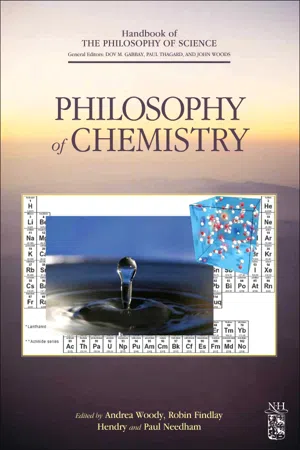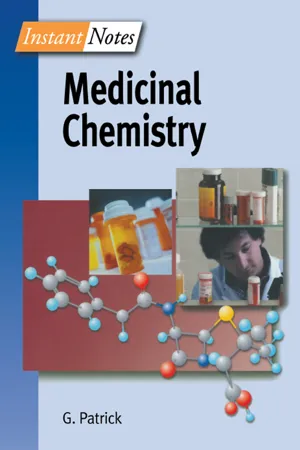Chemistry
Synthons
Synthons are hypothetical molecular fragments that are used as building blocks in retrosynthetic analysis, a method for planning the synthesis of complex molecules. They represent the disconnection of a molecule into simpler, readily available starting materials. By identifying synthons, chemists can work backwards from a target molecule to determine the most efficient route for its synthesis.
Written by Perlego with AI-assistance
Related key terms
Related key terms
1 of 4
Related key terms
1 of 3
3 Key excerpts on "Synthons"
- eBook - ePub
- Dov M. Gabbay, Paul Thagard, John Woods(Authors)
- 2011(Publication Date)
- North Holland(Publisher)
Goodwin, 2008 ]). Knowledge of reaction mechanisms will play a central role in all of these aspects of synthesis.The large-scale design of a synthesis requires a structural analysis of the target compound. The chemist must identify which features of the target are likely to be difficult to synthesize, and then identify a range of reactions that are candidates for producing those difficult features. By working backwards from the target and seeking to eliminate structural complexity in each (retrosynthetic) step by a range of plausible reactions, the chemist can generate a tree of plausible synthetic pathways leading from simpler organic compounds to the target molecule. Choosing among these plausible pathways is a complex process, but it will surely involve evaluating the synthetic effectiveness of the individual steps in these pathways. Such an evaluation will assess how effectively a particular proposed reaction would generate its proposed product from its proposed reactant. In the typical case, neither the proposed reactants nor the proposed products will be compounds for which there is any explicit data about the effectiveness of the proposed reaction. Instead, the organic chemist must use what he knows about the mechanism of the reaction and the structures of the proposed compounds in order to make this estimation. So, for instance, if the step being considered is the bromonation of an alkene and the synthesis requires this step to be stereospecific, then ‘knowing’ the mechanism of bromonation will be extremely useful. The organic chemist will look at the structure of the proposed alkene starting material to assess how electron withdrawing the substituents are. If the substituents are electron withdrawing, then the reaction is likely to proceed through a bromonium ion and so would probably result in stereospecific products. On the other hand, if the substituents were electron donating, then the reaction will likely be non-stereospecific because it proceeds through a standard carbocation. If, as is often the case, the substituents are mixed or are somewhere in-between, then the chemist knows that his choice of solvent will be important at this step. Additionally, the chemist might consider adding control steps to his synthesis, such as adding electron-withdrawing substituents in an earlier step, in order to manage the stereospecificity of the bromonation. It is clear, then, why the organic chemist involved in synthetic design would want to ‘know’ the mechanism of bromonation — this will allow intelligent choices to be made about which plausible pathways should be attempted in the laboratory. - eBook - ePub
- Takayuki Shioiri, Kunisuke Izawa, Toshiro Konoike(Authors)
- 2010(Publication Date)
- Wiley-VCH(Publisher)
Noyori, Nobel laureate, 2001 (Figure 1.3). Although the key requirements for a “synthesis with practical elegance” are highly challenging regarding efficiency, environmental impact, and economy, it is the obligation of responsible chemists to intensively and persistently strive for these goals. Figure 1.3 Chemical synthesis with practical elegance [1]. To illustrate the synthetic development process for new pharmaceuticals at F. Hoffmann-La Roche Ltd, Basel, Switzerland, the four examples shown in Figure 1.4 will be discussed and commented, examples already patented and/or published for which syntheses with technical potential were created. Three of them (Xenical™, Saquinavir™, Tamiflu™) finally reached the market place. Tempium, a monoamine oxidase type B (MAO-B) inhibitor, which finally was dropped, but is included in the discussion since substantial amounts have already been produced according to the final one-step process starting off from a nine-step discovery synthesis. Taking into account the fundamental differences of the synthetic strategies, it is very important to stress that a “comparison” of syntheses between the discovery chemistry route and the resulting synthesis created by synthesis and process research only with regard to the number of steps and overall yields is not admissible, since the key tasks, goals, and strategies of both areas are fundamentally different. As discussed above, the key task of discovery chemistry is to synthesize in a diversity-oriented manner – and as fast as possible – small amounts of new, biologically active molecules to be tested as potential clinical candidates. To this end, all available and sophisticated synthetic methods and separation techniques of modern organic chemistry should be applied - eBook - ePub
- Graham Patrick(Author)
- 2019(Publication Date)
- Taylor & Francis(Publisher)
N 2 nucleophilic substitution took place resulting in inversion of the asymmetric center and formation of the desired enantiomer (II). Thus, the desired enantiomer was obtained in 99% yield and 99% optical purity from the original racemic mixture.Fig. 15. Kinetic resolution and inversion of unwanted enantiomer.F3 COMBINATORIAL SYNTHESISKey NotesDefinitionCombinatorial synthesis involves the small-scale synthesis of large numbers of novel structures using automated solid phase synthetic procedures. Solid phase synthesisSolid phase synthesis is carried out on polymeric resins such as beads. Each bead is functionalized with linker molecules, which allow starting materials to be covalently bound to the bead. Structures are then constructed whilst attached to the bead. Synthetic intermediates do not need to be isolated and this allows an excess of reagent to be used at each reaction stage, which improves the overall yield.Parallel synthesisA parallel synthesis means that a common synthesis is carried out on a series of reaction vials, using different reactants and reagents for each vial. This will result in each vial containing a single identifiable product. The method is particularly useful for synthesizing large numbers of analogs for SAR studies and for drug optimization.Synthesis of mixturesCombinatorial synthesis can be used to produce a mixture of products in each reaction vial. This is useful in generating large quantities of structures when searching for a lead compound.
Index pages curate the most relevant extracts from our library of academic textbooks. They’ve been created using an in-house natural language model (NLM), each adding context and meaning to key research topics.
Explore more topic indexes
Explore more topic indexes
1 of 6
Explore more topic indexes
1 of 4


